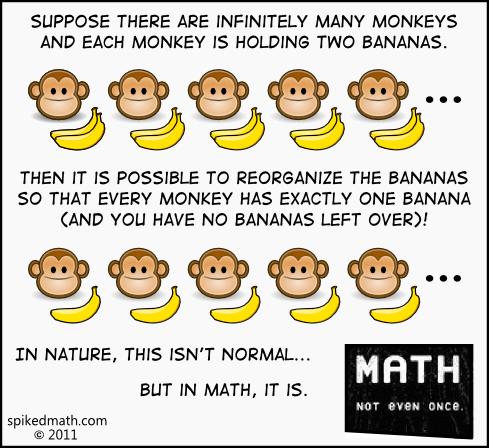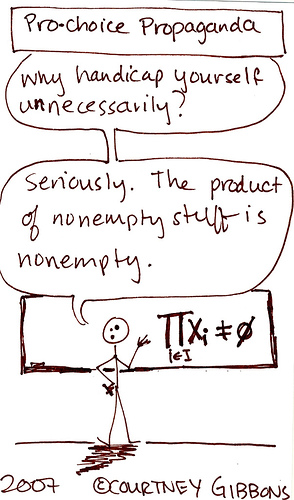Mastermath: Set Theory (spring 2011)
Here is the page
for this course at mastermath.nl.
Form of the exam
The exam will be closed book.
It will consist of
- 25 multiple choice questions designed to test your knowledge and insight of basic facts
and major results; here are some
sample questions
(more may follow).
- a number of open questions that will test your ability to reproduce/recreate/create proofs
of theorems given in class as well as your ability to come up with arguments for results that were
not necessarily included in the lectures; here are some
sample problems.
Program
- Week 1: Axioms
- An introduction to Set Theory with an explanation of the need for axioms.
The first three axioms: Extensionality, Existence of empty set, Pairing.
- Week 2: More Axioms
- The axioms of Union, power set, separation, infinity, replacement and
regularity.
A discussion of classes.
Homework: problems 1.4, 1.5, 1.14 and 1.15.
Hand in in week 3.
- Week 3:
Well-orderings and ordinal numbers
- Introduction to well-ordered sets and ordinal numbers.
Main results: any two well-ordered sets are comparable and
every well-ordered set is isomorphic to an ordinal number.
- Week 4:
Well-orderings and ordinal numbers and
Cardinal numbers

-
- Induction and recursion;
- ordinal arithmetic with Cantor normal form
(here is a
description of a set that represents the ordinal power and
a link to Goodstein's paper can be found on the Leiden set theory
page, see below);
- well-founded relations
- Definition of `the same cardinality' and a proof that a
the cardinality of a set is strictly smaller than that of its power
set.
Homework: problems 2.7, 2.8, 2.11 and 2.13.
Hand in in week 5.
- Week 5:
Cardinal numbers and Cardinal Arithmetic.
-
- Cantor-Bernstein Theorem;
- elementary cardinal arithmetic for cardinalities;
- definition of cardinal numbers and Hessenberg's theorem; the original
proof can be found
here (on page 109) and yet another proof,
by Jourdain, is
here;
- cofinality and regular versus singular; a model in which
ω1 is singular can be found in
Chapter 15
of the book (Example 15.57).
- Week 6:
Axiom of Choice.

- Some proofs that use the axiom of choice from ordinary mathematics,
recapitulation of Hartogs' Theorem, definition of choice functions,
definition of arbitrary sums and products of sets, various formulations of
the axiom of choice, fragments of the axiom of choice (e.g., countable
choice), some mathematical equivalents and consequences of the axiom of
choice (without proofs), equivalence of AC, the wellordering theorem, and
the comparability of cardinals. Definition of Zorn's Lemma.
Homework 5.1, 5.3 and 5.4.
Hand in in week 7.
(Theorem 4.5 of Chapter 4
may be useful).
- Week 7:
Axiom of Choice and Cardinal Arithmetic
-
- equivalence of AC and Zorn'sLemma
- cardinal arithmetic under the Axiom of Choice
- Week 8:
Axiom of Choice and Cardinal Arithmetic
and
The Axiom of Regularity
- Inaccessibility, SCH,
Axiom of Regularity vs Axiom Scheme of Regularity
(proof that the set version implies the class version),
Transitive Closure of a set,
von Neumann (cumulative) hierarchy,
proof (with regularity) that V is the universe,
Scott's Trick (cardinals without the AC),
Induction and Recursion on sets,
Axioms in the ranks Vα:
Vλ for λ>ω limit is a model of ZC,
Vω+ω does not satisfy Replacement.
Homework: Exercises 5.8, 5.15, 5.27, and 6.5.
Hand in in week 9.
As to the construction of Z, Q and R,
these are quite algebraic:
- Z is constructed from N using an
equivalence relation on the
pairs: ⟨k,l⟩ is equivalent to ⟨m,n⟩
if k+n=l+m
- Q is constructed from Z as its field of
quotients, via an
equivalence relation on Z×N>0:
⟨k,l⟩ is equivalent to ⟨m,n⟩
if k×n=l×m.
- R is constructed from Q as the set of
Dedekind cuts
(see page 39 of the book)
-
Week 9: Models of Set
Theory,
Inaccessible cardinals and
Measurable cardinals
-
Vα models Replacement implies α is a limit
cardinal and an ℵ-fixed point. κ inaccessible implies
Vκ models Replacement.
A hierarchy of large cardinal axioms:
- IC ("there is an inaccessible"),
- 2IC ("there are two inaccessibles"),
- nIC ("there are n inaccessibles"),
- OrdIC ("there is a proper class of inaccessibles"),
- "there is an inaccessible limit of inaccessibles".
Proof that this is a sequence strictly increasing in logical strength.
Measurable cardinals. Proof that a measurable cardinal is inaccessible.
- Week 10:
Measurable cardinals
and Combinatorial
set theory
- Three partition theorems: Ramsey, Erdos-Rado, Dushnik-Miller.
Homework: 10.4, 12.10, 9.5 and
the exercise in this file
(exercises 9.8 and 9.9 were about material that was not yet
covered in class).
This exercise needs a stronger property of measurable cardinals: namely
that they carry a normal ultrafilter, see page 134 and following.
Using this property one can show that the homogeneous set can be found
in the ultrafilter.
- Week 11:
Combinatorial
set theory
and Stationary sets
- More on weakly compact cardinals.
The order topology on ordinals. Closed unbounded and stationary sets.
The club filter. Mahlo cardinals.
Correction:
The proof of the statement done in the last few minutes of class
(``If κ is the least weakly inaccessible cardinal, then the set
of regular cardinals below κ is not stationary in κ.'')
was incorrect.
Here is a correction: As argued in class,
the set of limit cardinals less than κ is club in κ.
But since κ is the least weakly inaccessible, all limit
cardinals
below κ are singular, so the set S of singular cardinals is
club
in κ. The set Reg of regular cardinals below κ is disjoint
from S and hence not stationary.
- Week 12:
Stationary sets
and Combinatorial
set theory
- Mahlo cardinals, properties of the club filter, diagonal intersection,
Fodor's lemma, the tree property, every weakly compact cardinal has
the tree property.
Homework: 8.5, 8.6 and 9.9.
- Week 13: Weakly Compact Cardinals and
Powers of singular
cardinals
- Finished the discussion of weakly compact cardinals with
compactness for infinitary logics.
Silver's theorem on the GCH at singular cardinals of uncountable
cofinality.
- Week 14:
Powers of singular
cardinals
- The Galvin-Hajnal theorem.
Ordinal functions and scales.
Homework: 17.17, 17.19, 24.2, 24.6.
Two other sources:
Burke and Magidor and
Abraham and Magidor.
- Week 15:
Powers of singular
cardinals
- We finished the proof of 24.8.
After a discussion of the reasons for studying the powers of
singular cardinals we talked about
elementary substructures
of H(θ) and we looked ahead at what pcf can tell us about,
specifically, 2ℵω.
We embarked upon
the proof of 24.18.
Thus far we did 24.10, 24.19 and 24.20.
Here is a summary
of all we learned about cardinal exponentation in Chapter 8.
Here is the
paper by Kojman and Shelah on the normal space whose product
with the interval [0,1] is not normal.
- Week 15:
Powers of singular
cardinals
- We finished the proof of Theorem 24.18.
We ended the course with a sketch/overview of the proof of
Theorem 24.33; the theorem on Club-guessing sequences is in
Chapter 23.
The
chapter on cardinal arithmetic by Abraham and Magidor
in the Handbook of Set Theory is highly recommended reading;
it contains forms of Theorems 24.18 and 24.33 that do not need
the strong limit assumptions on ℵω.
Literature
We shall be using the following text:
T. Jech,
Set Theory. The Third Millenium Edition.
Some universities have access to the on-line version of this book;
check the link on the campus of your university.
We also recommend the following books
- K. Kunen, Set Theory. An introduction to Independence proofs
- Y. N. Moschovakis,
Notes on Set Theory
- K. J. Devlin, The Joy of Sets.
Course in Leiden
Here is a link to a course in Set Theory
in Leiden.
It contains links to the original works of Cantor and others.
Other material
Here is Bernard Bolzano's
Paradoxien des Unendlichen; the bijection between the intervals [0,5] and
[0,12] is discussed on page 29.
K_dot_P_dot_Hart_at_TUDelft_dot_nl
Last modified: Friday 12-04-2013 at 10:15:39 (CEST)

